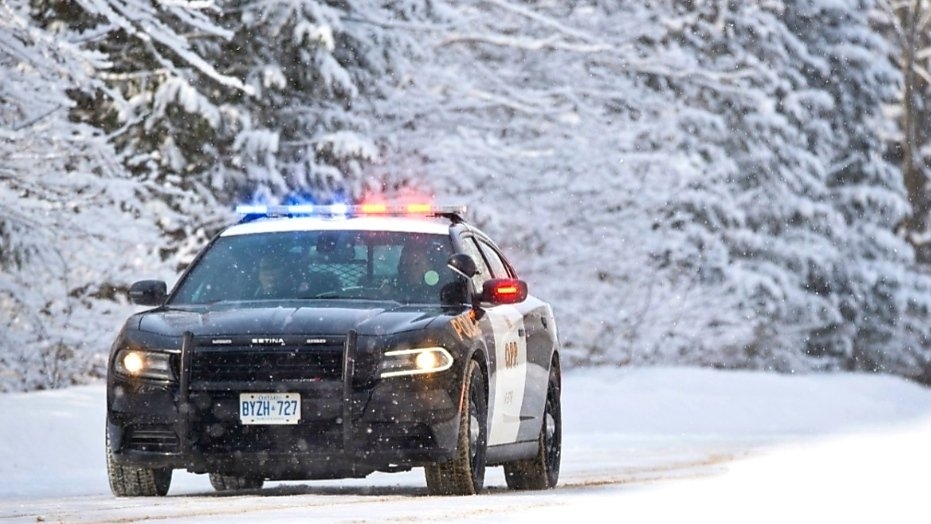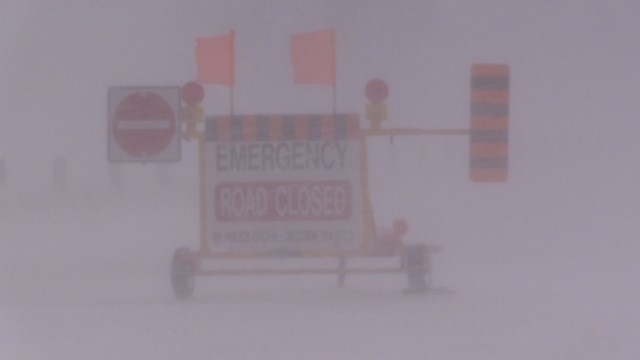Three drivers charged after driving on closed highway during storm
 A provincial police cruiser navigates snowy weather in Ontario. (OPP_CR)
A provincial police cruiser navigates snowy weather in Ontario. (OPP_CR)
The snow squalls that paralyzed midwestern Ontario over the weekend kept OPP very busy, and now they’re offering drivers some needed advice on winter driving after responding to more than 36 traffic calls and laying several charges.
According to a press release from South Bruce OPP, from 6:30 p.m. on Nov. 17 and 2:05 p.m. on Nov. 20, South Bruce OPP responded to a total of 36 traffic calls, in addition to other calls for assistance.
Police said the additional calls involved car crashes, cars stopped in live lanes of traffic, cars left on the shoulder of the road and cars in ditches.
According to Inspector Krista Miller, OPP officers responded to a two-vehicle crash and two calls for vehicles that skid into the ditch on a closed highway. Miller said the highway was closed for safety due to pockets of “zero visibility” that caused dangerous driving conditions.
The three drivers were charged with driving on a closed highway.
“The consequences could have been so much worse,” said Miller. “Road safety is a shared responsibility, please do your part.”
 A road closed sign is seen in Bruce County during a snowstorm in December 2016. (Scott Miller/CTV News London)
A road closed sign is seen in Bruce County during a snowstorm in December 2016. (Scott Miller/CTV News London)
So what can drivers do to ensure they get to their destinations safely in the winter? Here is what OPP recommends:
- Many wintertime crashes are caused by speeding in hazardous conditions, so “if you see snow — go slow”
- Check weather and travel conditions before heading out, and give yourself plenty of time to get to your destination. If road conditions are too dangerous, postpone your trip
- If caught in bad weather, tune into a local radio station for road closure updates
- Carry a winter survival kit inside your car that contains extra clothing, winter boots, snacks, blankets, a candle and waterproof matches
- Prepare your vehicle before travel by clearing snow and ice from the front, side, rear and top. The snow will blow off as you drive, but the mini snowstorm caused in the vehicle’s wake can be hazardous to drivers behind you
“Remember — an ordinary driver reacts to the changing road and weather conditions while a good driver anticipates problems before they occur,” OPP said. “Slow down and give everyone a chance to arrive safely at their destination.”
CTVNews.ca Top Stories

Joly, Blair condemn anti-NATO protest in Montreal that saw fires, smashed windows
Federal cabinet ministers condemned an anti-NATO protest in Montreal that turned violent on Friday, saying 'hatred and antisemitism' were on display.
NEW Thinking about taking an 'adult gap year'? Here's what experts say you should know
Canadian employees are developing an appetite for an 'adult gap year': a meaningful break later in life to refocus, refresh and indulge in something outside their daily routine, according to experts.
Canada Post down eight million parcels amid strike as talk carry on over weekend
Canada Post says it has seen a shortage of more than eight million parcels amid the ongoing strike that has effectively shut down the postal system for nine days compared with the same period of 2023.
'Her shoe got sucked into the escalator': Toronto family warns of potential risk of wearing Crocs
A Toronto family is speaking out after their 10-year-old daughter's Crocs got stuck in an escalator, ripping the entire toe area of the clog off.
Walking pneumonia is surging in Canada. Is it peaking now?
CTVNews.ca spoke with various medical experts to find out the latest situation with the typically mild walking pneumonia in their area and whether parents should be worried.
Prime Minister Trudeau attends Taylor Swift's Eras Tour in Toronto with family
Prime Minister Justin Trudeau is a Swiftie. His office confirmed to CTV News Toronto that he and members of his family are attending the penultimate show of Taylor Swift's 'The Eras Tour' in Toronto on Friday evening.
Minister calls GST holiday, $250 cheques for 18 million Canadians 'a targeted approach'
Women and Gender Equality and Youth Minister Marci Ien is calling the federal government's proposed GST holiday and $250 rebate cheques a 'targeted approach' to address affordability concerns.
Afraid of losing the U.S.-Canada trade pact, Mexico alters its laws and removes Chinese parts
Mexico has been taking a bashing lately for allegedly serving as a conduit for Chinese parts and products into North America, and officials here are afraid a re-elected Donald Trump or politically struggling Prime Minister Justin Trudeau could try to leave their country out of the U.S.-Mexico-Canada free trade agreement.
Canada's tax relief plan: Who gets a cheque?
The Canadian government has unveiled its plans for a sweeping GST/HST pause on select items during the holiday period. The day after the announcement, questions remain on how the whole thing will work.


































